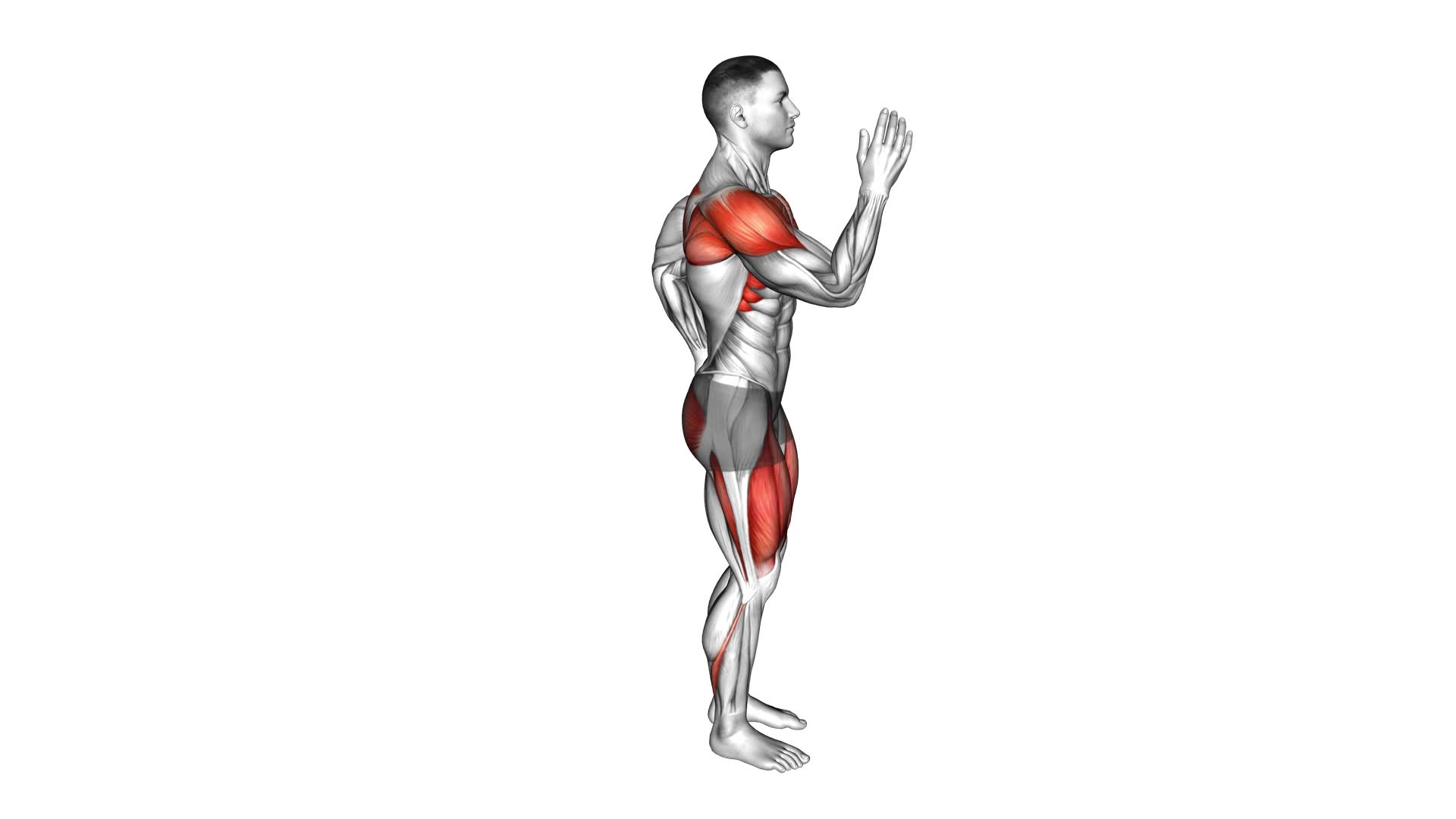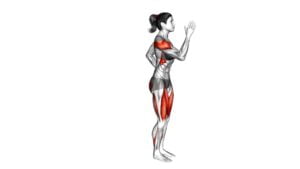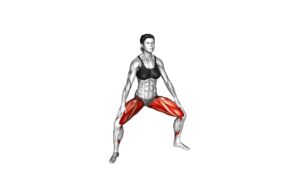Reverse Lunge Quick Arms (male) – Video Exercise Guide & Tips

Looking to tone your arms and legs? Check out this video exercise guide for the Reverse Lunge Quick Arms workout.
Watch This Exercise Video
This workout targets multiple muscle groups, helping you build strength and improve your overall fitness.
With proper form and technique, along with a recommended dumbbell weight, you'll be on your way to achieving your fitness goals.
Whether you're a beginner or looking to maximize your results, this article provides helpful tips and modifications to make the most out of your workout.
Let's get started!
Key Takeaways
- Reverse lunge quick arms targets multiple muscle groups.
- Proper form and technique are crucial to maximize the benefits of this exercise.
- Using the appropriate dumbbell weight and modifying for beginners is important.
- Maximizing results and ensuring safety can be achieved by incorporating progressive overload and maintaining proper form.
Benefits of Reverse Lunge Quick Arms
Improve your overall strength and stability with the benefits of Reverse Lunge Quick Arms.
This exercise not only targets your lower body, but also engages your upper body, making it a great choice for a full-body workout.
One of the key benefits of Reverse Lunge Quick Arms is improved balance. By performing the exercise, you challenge your body to maintain stability while moving in a controlled manner. This helps to strengthen your core and improve your overall balance.
Additionally, Reverse Lunge Quick Arms can also help increase calorie burn. By incorporating both the lower body lunge and the upper body arm movements, you engage multiple muscle groups simultaneously, leading to a higher calorie expenditure. This makes it an effective exercise for those looking to burn calories and lose weight.
To perform Reverse Lunge Quick Arms, start by standing with your feet hip-width apart. Take a step back with your left leg, lowering your body into a lunge position. As you lunge, simultaneously lift your arms up to shoulder height. Return to the starting position and repeat on the other side. Aim for 10-12 repetitions per leg for a complete workout.
Incorporating Reverse Lunge Quick Arms into your fitness routine can help you achieve improved balance and increased calorie burn. Give it a try and experience the benefits for yourself.
Proper Form and Technique
Mastering the proper form and technique for Reverse Lunge Quick Arms is essential for maximizing the effectiveness of this exercise. To ensure you're performing this exercise correctly, follow these guidelines:
- Start by standing with your feet hip-width apart and holding dumbbells in each hand, palms facing your body.
- Take a step back with your right foot, lowering your body into a lunge position. Keep your left knee directly above your ankle and your right knee hovering just above the ground.
- As you lower into the lunge, simultaneously curl the dumbbells toward your shoulders, keeping your elbows close to your sides.
- Push through your left heel to return to the starting position, extending your arms back down to your sides.
Common mistakes to avoid during this exercise include:
- Allowing your front knee to extend beyond your toes.
- Arching your back or leaning forward excessively.
- Using momentum to swing the weights instead of engaging your biceps.
To progress this exercise, you can increase the weight of the dumbbells or add more repetitions. You can also try variations such as performing the reverse lunge with a shoulder press, incorporating a twist at the torso, or performing the exercise on an unstable surface.
Now that you understand the proper form and technique, let's move on to determining the recommended dumbbell weight.
Recommended Dumbbell Weight
To determine the appropriate dumbbell weight for the Reverse Lunge Quick Arms exercise, assess your current strength level and choose a weight that challenges you without compromising proper form. The ideal dumbbell weight will differ for each individual, as it depends on factors such as your fitness level and experience with strength training. It's important to start with a weight that you can comfortably handle while maintaining proper form throughout the exercise. This will help prevent injuries and ensure effective results.
One common mistake when selecting dumbbell weight is choosing a weight that's too heavy. This can lead to improper form and increase the risk of injury. On the other hand, choosing a weight that's too light may not provide enough resistance to effectively work the muscles. It's important to find a balance between challenging yourself and maintaining proper form.
Another mistake is using different weights for each arm. This can result in muscle imbalances and uneven strength development. Be sure to use the same weight for both arms to ensure balanced strength and muscle growth.
Modifications for Beginners
To ensure proper form and prevent injuries, beginners can make modifications to the Reverse Lunge Quick Arms exercise by starting with lighter dumbbells and focusing on mastering the technique before increasing weight.
Here are some beginner modifications and common mistakes to avoid:
- Use lighter dumbbells: Begin with a weight that feels comfortable and allows you to maintain proper form throughout the exercise. As you become more confident and proficient, gradually increase the weight.
- Focus on technique: Pay close attention to your form during each rep. Ensure that your knees are aligned with your toes and that you maintain a straight back throughout the movement. Engage your core and keep your shoulders relaxed.
- Start with a shorter range of motion: If you find it challenging to perform the exercise with a full lunge, start with a smaller step backward and gradually increase the range of motion as you build strength and stability.
By implementing these modifications, beginners can gradually progress and build strength without putting excessive strain on their muscles and joints.
Remember to listen to your body and make adjustments accordingly. With consistency and proper technique, you'll be able to perform the Reverse Lunge Quick Arms exercise effectively and safely.
Tips for Maximizing Results
To maximize your results, focus on incorporating progressive overload into your Reverse Lunge Quick Arms routine. Progressive overload means gradually increasing the demand on your muscles over time, whether by adding weight, increasing repetitions, or reducing rest time. This will challenge your muscles and help them grow stronger and more toned.
One of the most common mistakes people make during the Reverse Lunge Quick Arms exercise isn't maintaining proper form. It's important to keep your back straight, shoulders relaxed, and core engaged throughout the movement. Avoid leaning forward or rounding your back, as this can put unnecessary strain on your lower back and increase the risk of injury.
Another important aspect to consider is your breathing technique. Remember to breathe in through your nose and out through your mouth during the exercise. Inhale as you lower your body into the lunge and exhale as you push back up. This helps oxygenate your muscles and provides them with the necessary energy to perform the exercise effectively.
Frequently Asked Questions
How Long Should I Rest Between Sets of Reverse Lunge Quick Arms?
To optimize your workout and give your muscles enough time to recover, it's important to rest between sets of reverse lunge quick arms.
The rest duration can vary depending on your fitness level and goals, but generally, a rest period of 30-60 seconds is recommended. This allows your muscles to recover and replenish energy before the next set.
Can Reverse Lunge Quick Arms Help With Weight Loss?
Reverse lunge variations, like the quick arms, can definitely aid in weight loss. By incorporating quick arm movements into your reverse lunge exercise, you're engaging more muscles and increasing your overall calorie burn.
This combination of lower body and upper body movements helps to elevate your heart rate and boost your metabolism. Additionally, the quick arm movements help to strengthen and tone your arms, giving you a more complete full-body workout.
Are There Any Potential Risks or Injuries Associated With Reverse Lunge Quick Arms?
When doing the reverse lunge quick arms exercise, there are potential risks and injuries that you need to be aware of. These can include straining your muscles or joints if you don't use proper form or overexert yourself.
It's important to listen to your body and start with lighter weights or modifications if you're a beginner. Always warm up before and stretch after the exercise to reduce the risk of injury.
Can Reverse Lunge Quick Arms Be Done Without Dumbbells?
Yes, you can modify the reverse lunge quick arms exercise if you don't have dumbbells. Instead of using dumbbells, you can hold a kettlebell in one or both hands during the exercise.
This will still provide resistance and work your arms, while also engaging your lower body muscles. Remember to maintain proper form and control throughout the movement to maximize the benefits and prevent injuries.
How Often Should I Incorporate Reverse Lunge Quick Arms Into My Workout Routine?
To incorporate reverse lunge quick arms into your workout routine, consider your fitness level and goals.
Start by doing them 2-3 times a week, with a day of rest in between. As you progress, you can increase the frequency to 4-5 times a week.
Remember to listen to your body and adjust as needed. To modify for beginners, start without dumbbells and focus on proper form. Gradually add weights as you get stronger.
Conclusion
In conclusion, the reverse lunge quick arms exercise is a highly effective workout that targets multiple muscle groups and improves overall strength and stability.
By following proper form and technique, using the recommended dumbbell weight, and incorporating modifications for beginners, you can maximize the benefits of this exercise.
Remember to stay consistent and challenge yourself to see the best results.
Keep up the great work!

Author
Years ago, the spark of my life’s passion ignited in my mind the moment I stepped into the local gym for the first time. The inaugural bead of perspiration, the initial endeavor, the very first surge of endorphins, and a sense of pride that washed over me post-workout marked the beginning of my deep-seated interest in strength sports, fitness, and sports nutrition. This very curiosity blossomed rapidly into a profound fascination, propelling me to earn a Master’s degree in Physical Education from the Academy of Physical Education in Krakow, followed by a Sports Manager diploma from the Jagiellonian University. My journey of growth led me to gain more specialized qualifications, such as being a certified personal trainer with a focus on sports dietetics, a lifeguard, and an instructor for wellness and corrective gymnastics. Theoretical knowledge paired seamlessly with practical experience, reinforcing my belief that the transformation of individuals under my guidance was also a reflection of my personal growth. This belief holds true even today. Each day, I strive to push the boundaries and explore new realms. These realms gently elevate me to greater heights. The unique combination of passion for my field and the continuous quest for growth fuels my drive to break new ground.







